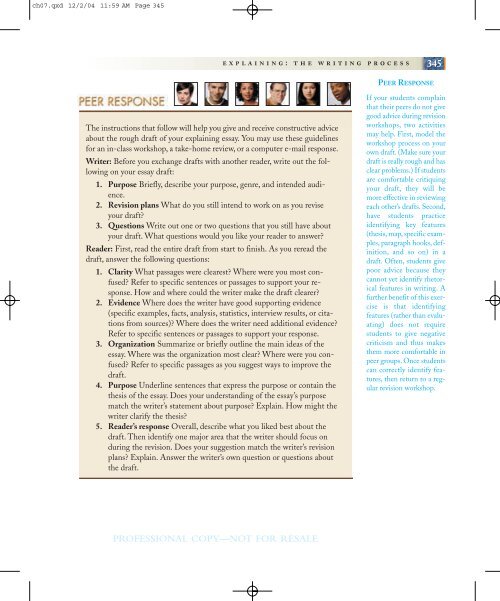A prolific painter of portraits before and after the French Revolution ...
A prolific painter of portraits before and after the French Revolution ...
A prolific painter of portraits before and after the French Revolution ...
Create successful ePaper yourself
Turn your PDF publications into a flip-book with our unique Google optimized e-Paper software.
ch07.qxd 12/2/04 11:59 AM Page 345<br />
explaining:<br />
<strong>the</strong> writing process<br />
345<br />
PEER RESPONSE<br />
The instructions that follow will help you give <strong>and</strong> receive constructive advice<br />
about <strong>the</strong> rough draft <strong>of</strong> your explaining essay. You may use <strong>the</strong>se guidelines<br />
for an in-class workshop, a take-home review, or a computer e-mail response.<br />
Writer: Before you exchange drafts with ano<strong>the</strong>r reader, write out <strong>the</strong> following<br />
on your essay draft:<br />
1. Purpose Briefly, describe your purpose, genre, <strong>and</strong> intended audience.<br />
2. Revision plans What do you still intend to work on as you revise<br />
your draft?<br />
3. Questions Write out one or two questions that you still have about<br />
your draft. What questions would you like your reader to answer?<br />
Reader: First, read <strong>the</strong> entire draft from start to finish. As you reread <strong>the</strong><br />
draft, answer <strong>the</strong> following questions:<br />
1. Clarity What passages were clearest? Where were you most confused?<br />
Refer to specific sentences or passages to support your response.<br />
How <strong>and</strong> where could <strong>the</strong> writer make <strong>the</strong> draft clearer?<br />
2. Evidence Where does <strong>the</strong> writer have good supporting evidence<br />
(specific examples, facts, analysis, statistics, interview results, or citations<br />
from sources)? Where does <strong>the</strong> writer need additional evidence?<br />
Refer to specific sentences or passages to support your response.<br />
3. Organization Summarize or briefly outline <strong>the</strong> main ideas <strong>of</strong> <strong>the</strong><br />
essay. Where was <strong>the</strong> organization most clear? Where were you confused?<br />
Refer to specific passages as you suggest ways to improve <strong>the</strong><br />
draft.<br />
4. Purpose Underline sentences that express <strong>the</strong> purpose or contain <strong>the</strong><br />
<strong>the</strong>sis <strong>of</strong> <strong>the</strong> essay. Does your underst<strong>and</strong>ing <strong>of</strong> <strong>the</strong> essay’s purpose<br />
match <strong>the</strong> writer’s statement about purpose? Explain. How might <strong>the</strong><br />
writer clarify <strong>the</strong> <strong>the</strong>sis?<br />
5. Reader’s response Overall, describe what you liked best about <strong>the</strong><br />
draft. Then identify one major area that <strong>the</strong> writer should focus on<br />
during <strong>the</strong> revision. Does your suggestion match <strong>the</strong> writer’s revision<br />
plans? Explain. Answer <strong>the</strong> writer’s own question or questions about<br />
<strong>the</strong> draft.<br />
If your students complain<br />
that <strong>the</strong>ir peers do not give<br />
good advice during revision<br />
workshops, two activities<br />
may help. First, model <strong>the</strong><br />
workshop process on your<br />
own draft. (Make sure your<br />
draft is really rough <strong>and</strong> has<br />
clear problems.) If students<br />
are comfortable critiquing<br />
your draft, <strong>the</strong>y will be<br />
more effective in reviewing<br />
each o<strong>the</strong>r’s drafts. Second,<br />
have students practice<br />
identifying key features<br />
(<strong>the</strong>sis, map, specific examples,<br />
paragraph hooks, definition,<br />
<strong>and</strong> so on) in a<br />
draft. Often, students give<br />
poor advice because <strong>the</strong>y<br />
cannot yet identify rhetorical<br />
features in writing. A<br />
fur<strong>the</strong>r benefit <strong>of</strong> this exercise<br />
is that identifying<br />
features (ra<strong>the</strong>r than evaluating)<br />
does not require<br />
students to give negative<br />
criticism <strong>and</strong> thus makes<br />
<strong>the</strong>m more comfortable in<br />
peer groups. Once students<br />
can correctly identify features,<br />
<strong>the</strong>n return to a regular<br />
revision workshop.<br />
PROFESSIONAL COPY—NOT FOR RESALE

















